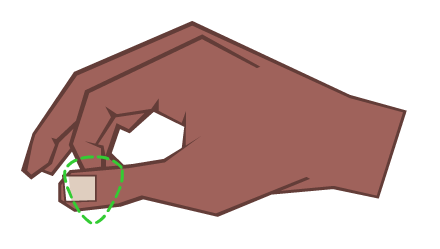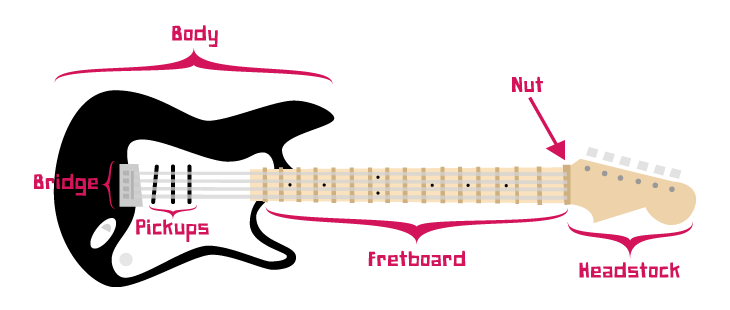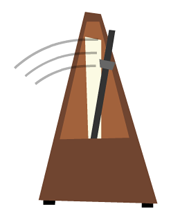The Guitar
Here you can find a guitar tuner and some general info on practicing the guitar!
Are you in tune?
Click on the pegs to hear the strings in tune and take a moment to tune your guitar.
Playing with a pick
 The exercises for the guitar on this website were written for players with picks. You can play them with your fingers but that kind of playing is unfortunately not that covered in the exercises. A lot of exercises have to do with how your pick strikes the string (from which direction and at which angle).
The exercises for the guitar on this website were written for players with picks. You can play them with your fingers but that kind of playing is unfortunately not that covered in the exercises. A lot of exercises have to do with how your pick strikes the string (from which direction and at which angle).
Hold the pick with two fingers (your thumb and forefinger) as shown in the figure:
The up and down picking motion should always come from the wrist and not from the elbow! Keep that in mind when playing.
As for the thickness of the pick - try different sizes and see which is more comfortable. Buy a couple and see which feels the most comfortable and gives you the most control while playing.
The guitar in general

Take a moment and familiarize yourself with the parts of the guitar so that we are on the same page with the terminology throughout the exercises.
Playing with an amp
For most of these exercises it is not necesary to play them using any kind of amplification, you can even play them on an unplugged guitar. But remember, you need to hear yourself play! No need to play at full volume or use any kind of effects, just make sure to hear what you're playing.
Often times it's good practice to record yourself playing so that you can listen and objectively hear your strong and weak points. When playing you don't always hear what's coming out of the amp in the same way as you would hear someone else play - probably because you're focusing more on the mechanics of playing and not just listening. Keeping old recordings of yourself is also a good motivator. Whenever you feel down about your skills you can listen to how you sounded six month ago.
How to read tabs
In order to follow exercises on this website you need to know how to read tablature.
Reading tablature is really easy and is specially made for the guitar. Tablature gives you pitches (or notes) by showing the string and fret number where the note is found. Horizontal lines represent the strings (the bottom line is the low E string - the thickest string). The numbers on the strings tell you what frets to play. If the number is zero than you do not fret the string, you play an open string.
Here's an example of some tabs combined with standard notation:
 So this tablature shows you how to play four notes on the high E string. You play (in succession) the 10th fret, the 12th fret, the 13th fret and again the 12th fret. The C at the start of the tabs tells you that this is in regular time, this means that one measure is four beats long. Other time signatures found in the exercises are either 3/4 or 2/4 (three beats in a measure or two beats in a measure respectively).
So this tablature shows you how to play four notes on the high E string. You play (in succession) the 10th fret, the 12th fret, the 13th fret and again the 12th fret. The C at the start of the tabs tells you that this is in regular time, this means that one measure is four beats long. Other time signatures found in the exercises are either 3/4 or 2/4 (three beats in a measure or two beats in a measure respectively).
Two special symbols denote how to strike the string (from above the string or from below the string).
 - the downstroke symbol, your pick moves down to strike the string
- the downstroke symbol, your pick moves down to strike the string - the upstroke symbol, your pick moves up to strike the string
- the upstroke symbol, your pick moves up to strike the string
Each exercise written in tabs also has a synthesized recording of it so that you can listen to it - if you're unfamiliar with rhythm notation please learn it from the recorded sounds and apply that knowledge when reading the tabs.
Also take a moment to familiarzie yourself with the fretboard diagram:
Imagine that you are looking down at the neck of your own guitar. The thick bottom line is the low E string, the headstock is on the left side of the fretboard and the body on the right side of the fretboard. The dots on the fretboard correspond to the inlay on your fretboard as well.
Attention left handed guitarists - you can flip the fretboard by hovering over it with your mouse and clicking the switch to lefty button! The system will remember your preference if you are registered and signed in!
How to practice with the metronome
 Playing with the metronome helps you keep in rhythm. Practicing is not about the metronome going to the highest possible speed but about you staying in beat. Sometimes instead of speeding up the metronome you'd actually want to slow it down. Sometimes it's just as hard to play at really slow speeds as really high speeds.
Playing with the metronome helps you keep in rhythm. Practicing is not about the metronome going to the highest possible speed but about you staying in beat. Sometimes instead of speeding up the metronome you'd actually want to slow it down. Sometimes it's just as hard to play at really slow speeds as really high speeds.
The rule of thumb here is - don't change the tempo on the metronome until you're absolutely comfortable with it and playing an exercise at that tempo is the easiest thing in the world. And when it does feel like playing that exercise at that specific tempo is the most natural thing in the world to you, only change the tempo in small increments.
A free and useful metronome is of course included on the Music Discipline website. You will see it in the toolbar at the bottom of the page as soon as your practice session starts!
Posture
Sitting up or standing down - it doesn't matter, as long as you're comfortable. Playing guitar shouldn't be a stress on your body so try to make it as effortless as possible. The rule of thumb here is to keep your spine and wrists straight at all times!
And please, don't slouch over the guitar while looking at the fretboard. Your back and neck will thank me for this.